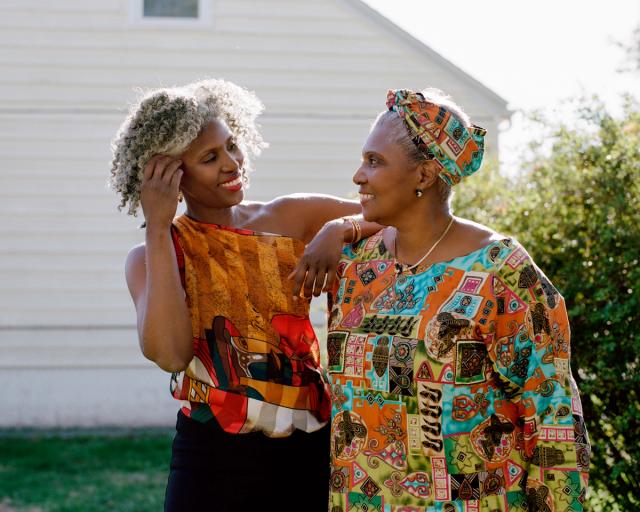

When I think of moments that are core to my memory, I see my grandmother cooking up something from the simplest meal to prepping for Sunday dinner on Saturday or buying all the key ingredients for New Year’s Day soup.
The one thing about the women in my family is that they made sure you ate and ate well, with plenty of servings to take home. Like most of us, food often brings us together, whether it's a celebration or a time of mourning - It's the community around the kitchen.

My fondest childhood memories were spent in the Bronx with my grandparents on any given weekend, holiday, or summer break with a room full of cousins and a house full of uncles and aunts. Any of my siblings or cousins could attest that the scent of sweet fried plantains would be the trail leading you to the kitchen, or the smell of epis smothered meals simmering on the stove would fill your belly before you even got a bite. Sneaking into the kitchen to taste test the food or grab a warm slice of freshly baked cake or piece of fried spicy meatballs was probably the biggest treat because I became the self-proclaimed food taster...and somehow, I knew my mother, grandmother or auntie loved the adoration. Cooking was and still is important because they got so much pride knowing every ounce of sweat earned from the steaming hot kitchen (no exaggeration) was worth every bite everyone in the house or visiting would enjoy.


"The kitchen belonged to the women and food was their special superpower."
I learned so much just by watching them cook and prep food. As a young girl, I could never figure out how they knew the amount of spice to use. I remember asking my grandmother, "Nana, how do you know how much to use?" With a simple answer, she'd take a spoon and dip it into the pot, pour a touch of food in her hand and taste, and answer, "You just know." There was an intention and wisdom there that went beyond a traditional Haitian recipe.
I often got recruited to help. I was the worse at peeling root vegetables because every attempt eventually turned into one of these women taking over. I'd do more simple things like rinsing the rice, soaking beans, and occasionally getting some time in front of a big pot whipping cake batter from scratch with these large hand-carved wooden spoons from Haiti. But honestly, I had way more pleasure watching them. Just being in the kitchen was not only a sneaky snack but a way to bond, talk and joke around. I always remember it being comforting and safe.

Ketlie Laurenceau
Here are my favorites from a very long list of traditional Haitian dishes:
aka: Black Rice, my favorite side dish
I can eat bowls of this flavorful seafood rice made with a small and spindly mushroom native to the northern region of Haiti known as Djon Djon. These mushrooms need only be soaked, and the soaking liquid is what makes this dish unique, offering an earthy taste and shrimp for an extra punch of deliciousness. Djon Djon gives this rice dish its signature black color. Sometimes people outside of Haitian culture refer to this as "Black Rice." You can find Djon Djon at a Haitian market or a Haitian vendor. It's not always easy to find, but if you do, grab a bag or two and know a little goes a long way. The dried Djon Djon will have a powerful earthy aroma.

aka Soupe de Giraumon, a savory pumpkin soup
If you're Haitian and/or are familiar with Haitian culture, this is one of the most memorable and cherished dishes. This soup is prepared for New Year’s Day. It represents our pride, solidarity, and remembrance of Haiti's independence as the first black republic in the Caribbean and internationally. This dish holds so much warmth and flavor. Bowls get passed around until the pot is empty.

Haitian Herb Seasoning - simple ingredients, bold flavor
This is the backbone of Haitian cuisine because it is the foundation of our unique flavor, offering so much versatility. This green paste is a combination of ingredients you more than likely already have or easily find at your local grocery. It's a wonderfully aromatic layered combination of peppers, garlic, scallions and habanero chili peppers (otherwise, scotch bonnet peppers will work fine) that is pureed to perfection. When we make this, we make a large batch and keep it ready in the refrigerator. Sometimes, we freeze into ice cubes for perfectly seasoned portions that you can melt down in your sauté pan or drop in a batch of soup or stew. We also use this to marinate seafood, poultry, pork, beef and even vegetarian dishes.

The Perfectly Hot Condiment
No Haitian kitchen is without this spicy condiment, our beloved Pikliz. There usually is at least 1 large jar resting in the refrigerator, and it moves fast because everyone loves it. But, thankfully, it's super easy to prepare and cures quickly in just a few days. But the longer it marinates, the more potent. Pikliz is a spicey slaw, a lively and tasty combination of fresh vegetables and hot peppers. It's perfect on just about anything from fried plantains, fish, beef, rice and beans, and the list can go on. I love this because you can turn up the heat by adjusting how much pepper you add. I use this weekly and add it to my soups, and sometimes add a touch to my beaten eggs right before making an omelet. It's versatile and works with many dishes.

To Ketlie Laurenceau for hosting Margot at her home and wowing us with her PIKLIZ and Soup Joumou. Also, to Prestige Restaurant in Pleasantville NJ for the additional Haitian dishes and sodas.
View Ketlie's recipes below.

